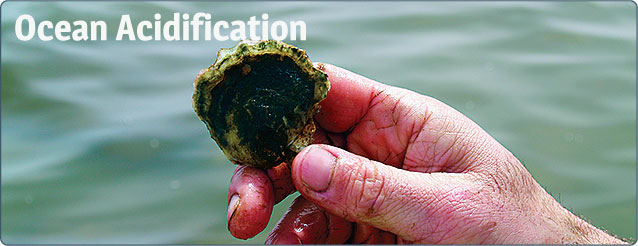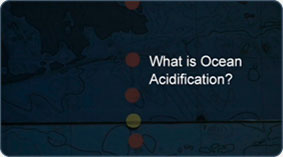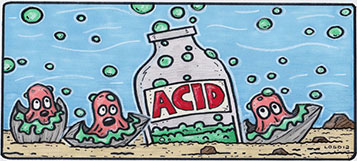
Photo Credit: Meredith Haas
Creeping Corrosion
“Climate change may be all over the headlines, but it has an evil twin, caused by the same invisible gas carbon dioxide, with more measurable, rapid and seemingly unstoppable effects.”
- Dan Laffoley, Marine Vice Chair, IUCN World Commission on Protected Areas
Ocean acidification is one of the less visible impacts of climate change. It is more akin to a slow-growing cancer than a fast-hitting flu. Since it is not easily understood or right in the average person’s face on a daily basis, ocean acidification may be a greater threat than more noticeable impacts such as increasing temperatures and rising sea levels.


NOAA Climate.gov: The Origin and Impacts of Ocean Acidification. Video copyright Oregon Sea Grant Communications, Oregon State University. Directed and produced by Joe Cone, videographer, and Stevon Roberts, video editor.
What is Ocean Acidification?
As more carbon dioxide is released into the atmosphere, more carbon dioxide is also absorbed by the oceans. When this happens the oceans become more acidic and have a lower pH. Why does this matter? Because the pH of any ecosystem is important to the plants and animals that live there. Think about that late night pepperoni pizza you had last week that caused you to wake up in the middle of the night with heartburn. The pepperoni pizza actually altered the pH of your stomach and the result was heartburn — aka acid indigestion. The oceans are getting acid indigestion like you have never experienced.
What Does Acidification Do?
Acidification is particularly harmful to marine animals that have shells or skeletons made of calcium carbonate such as quahogs (and, yes, we’re talking about “stuffies” here), sea stars and corals. The reason why is a chemical process that reminds you of high school chemistry. If you want to avoid a trip down memory lane, the bottom line is this: an ocean with a lower pH has less of the ingredients animals need to make the calcium carbonate in their shells and skeletons. If you want more details see the explanation below.
by Arthur Mead, Jr.

Clams on the “No” Shell — Ocean acidification brought on by climate changes dissolves the shells of clams and oysters, as well as lobsters and crabs.
Ocean acidification impacts different species in different ways, and this remains an area of intense interest to scientists. Ocean acidification could reduce the metabolic rate — which means less energy — of marine organisms. Ocean acidification can lower the amount of oxygen blood can carry. If pH gets too low, then not enough oxygen makes it through the animals and they die. However, one way to cope with ocean acidification is metabolic suppression. That is just a fancy way of saying “use less energy”. If an animal uses less energy — not swimming as much, not putting as much energy into reproduction — then they won’t need as much oxygen. This is very common in animals that move around a lot. If they can’t carry enough oxygen in their bodies where they are currently, they suppress their metabolism and swim off to greener pastures where they will then go back to business as usual. But, if the whole ocean becomes more acidic and lowers oxygen in animals, then there may not be greener pastures to find and lower reproduction rate and death may become more and more common. When you consider that all animals are connected to others in the food chain, you can start to see how ocean acidification has the potential for widespread consequences.
Lower pH also may also corrode metals on vessels and infrastructure associated with marine transportation, navigation, ports and harbors resulting in a higher cost to maintain these structures or the need to replace them more frequently. Ocean acidification may also cause more rapid deterioration of historic and cultural assets on the seafloor, ranging from high profile artifacts like the RMS Titanic or the Lusitania to millions of merchant vessels whose cultural secrets are waiting to be uncovered. We are in an age of rapidly increasing capacity to explore the ocean floor but it could prove to be a race against time as acidity threatens artifacts.
Dig Deeper: The Science of Why Acidification is Happening
- Roughly one-half of the carbon emitted from human activities between 1800 and 1994 has been absorbed by the ocean. Just imagine throwing that much bubble bath in the tub. Your house would look like a cartoon with bubbles spewing out of chimney tops. Carbon is not evidenced by any obvious images; it is there nonetheless.
- One-third of carbon emissions coming from automobiles and factories as we speak are being absorbed by the ocean.
- Carbon dioxide in the surface waters of our world’s oceans has increased 13.2 percent since 1981.This has resulted in a reduction of surface water pH by 0.1. (Remember: pH units are expressed on a logarithmic scale, so a pH change of one represents a 10-fold change, and a pH change of 2 is a 100-fold change.)
- Although the impacts of ocean acidification to larval temperate fish are still unknown, reef fish have shown that decreases in pH can disrupt the olfactory (aka smell) cues used by larval fish to find suitable habitat. And, if they can’t find a place to live, they’ll die.
- Impacts to reproduction and larval development have already been shown in a lab setting, but additional possible impacts could include effects on how the larvae fend of diseases, and development at other life stages.
“People may pay attention when they look at a restaurant menu and are offered, ‘Clams on the no shell.’”
- Anonymous
Ocean acidification — the excess carbon dioxide in the atmosphere that is turning the oceans increasingly acid — is a slow but accelerating impact with consequences that will greatly overshadow all the oil spills put together.
- Sylvia Earle
News
Factoids
Roughly 50% of the carbon emitted from human activities between 1800 and 1994 has been absorbed by the ocean. Increased carbon in the oceans is not something you can readily see, but it is there nonetheless.
One-third of carbon emissions today from automobiles and factories are currently being absorbed by the ocean.
Impacts to reproduction and larval development have already been shown in a lab setting, but additional possible impacts could include effects on immunity and development at other life stages.




